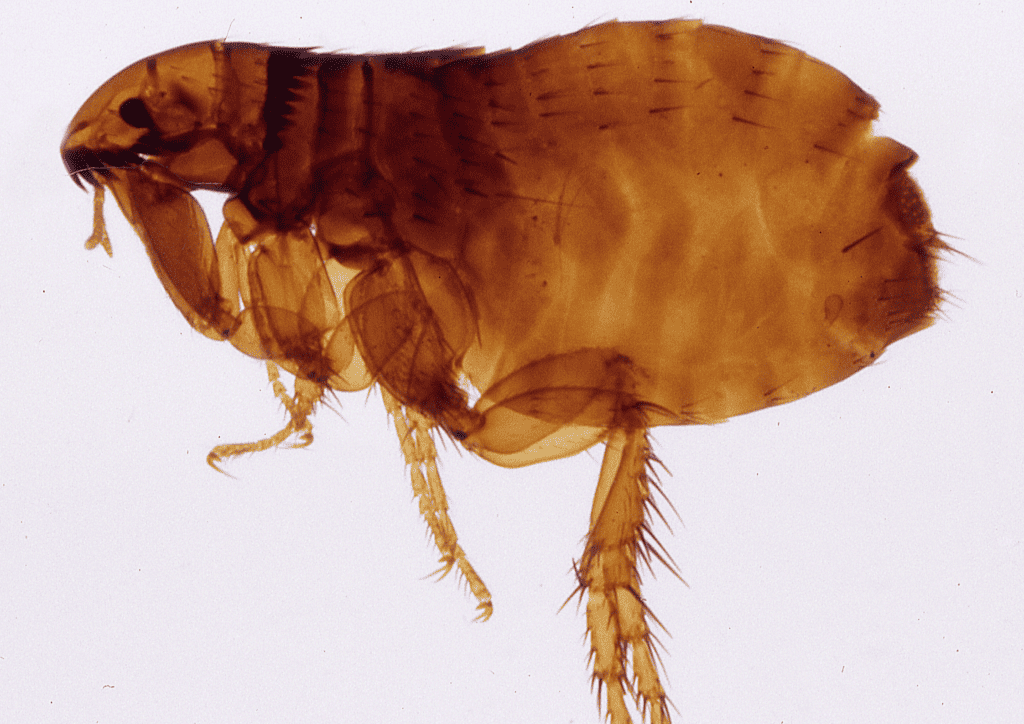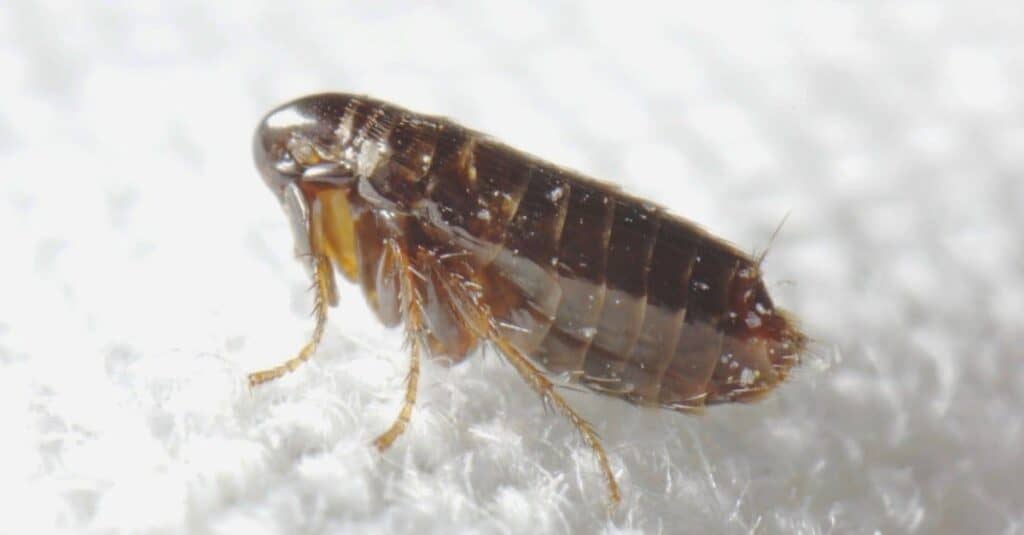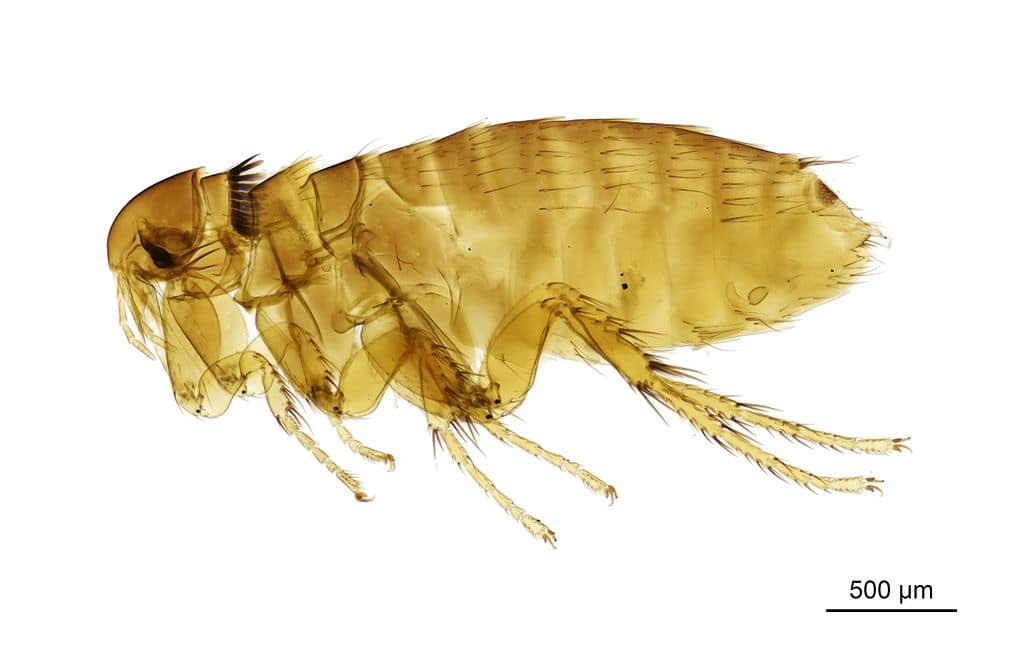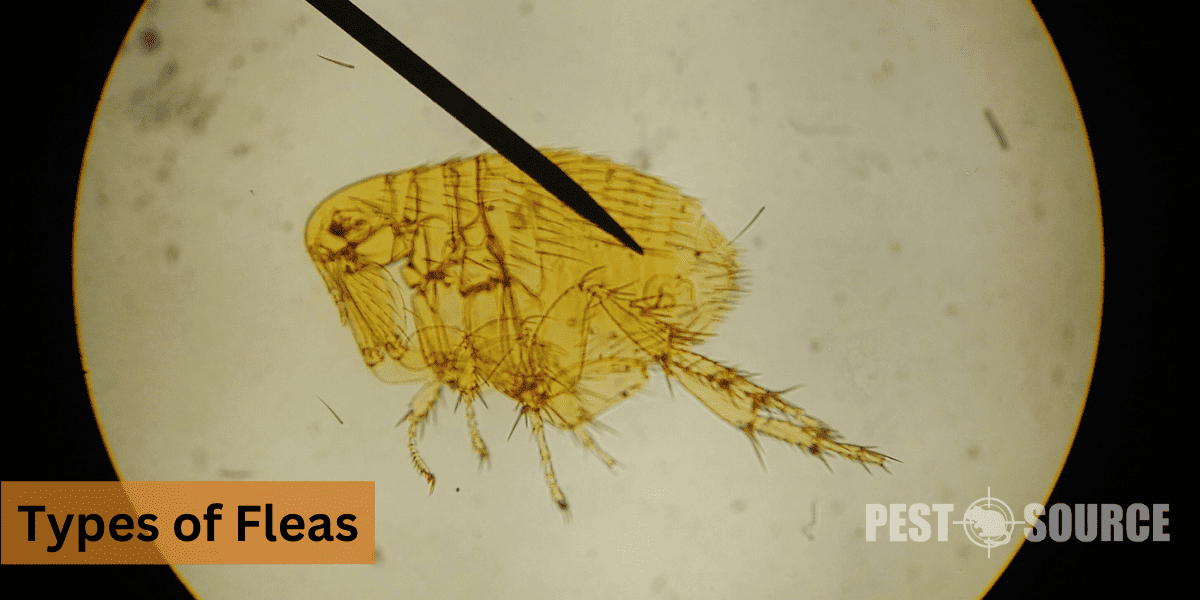Fleas are pesky, wingless parasites that can infest both pets and humans, causing itching, irritation, and even transmitting diseases. With over 2,000 known species worldwide, it’s crucial to understand the different types of fleas, how they affect various hosts, and how to effectively combat infestations.
In this article, we’ll delve into the diverse world of fleas, discussing their characteristics, distribution, and preferred hosts, while also providing practical advice for identifying, treating, and controlling flea infestations.
POINTS
- There are over 2,000 known species of fleas worldwide, with some of the most common types affecting humans and pets including cat fleas, dog fleas, and human fleas.
- Fleas are found in various environments across the globe, thriving especially in warm and humid conditions.
- To effectively combat flea infestations, it’s crucial to treat both your pets and your home environment using a combination of methods such as medications, cleaning, and flea-specific treatments.
- Persistent monitoring and consistent treatment efforts are essential in managing flea infestations and preventing re-infestations.
- In cases of severe flea infestations, professional extermination services may be necessary to ensure complete elimination and prevent further problems.
Understanding Fleas: Basic Introduction and Common Misconceptions
What are fleas?
Fleas are small, wingless parasites that live by consuming the blood of their hosts, such as mammals and birds. They are known for their impressive jumping abilities, due in part to their long and powerful hind legs. Fleas can be a nuisance to both humans and animals, causing discomfort through their bites and, in some cases, transmitting diseases.
Are fleas common?
Yes, fleas are common worldwide and have been around for millions of years. They are well-adapted to various environments, making them difficult to avoid entirely. Fleas thrive in warm, humid conditions, making them particularly abundant during the warmer months of the year.
Why do fleas exist?
Fleas, much like other members of the animal kingdom, are part of the natural ecosystem. They serve as food sources for other organisms, such as birds and certain insects. While they may seem like pests to us, their existence plays a role in maintaining the balance of our ecological system.
The Diversity of Fleas: Classifications and Species
How many species of fleas are there?
There are over 2,000 recognized species of fleas worldwide, each uniquely adapted to its respective host and environment.
What are the different types of fleas?
Although there are many different species of fleas, some of the most common types that affect humans and pets include:
| Common Name | Scientific Name | Common Hosts | Distinctive Features |
|---|---|---|---|
| Cat Flea | Ctenocephalides felis | Cats, Dogs | Reddish-brown, 1-3 mm length, jumps up to 1 foot |
| Dog Flea | Ctenocephalides canis | Dogs, Cats | Darker than cat flea, slightly larger, infests cats too |
| Human Flea | Pulex irritans | Humans, Pigs | Larger, darker, infests humans and pigs |
| Rat Flea | Xenopsylla cheopis | Rats, can affect humans | Transmits plague, prefers warm climates |
| Bird Flea | Ceratophyllus gallinae | Various bird species | Infests birds, can jump to pets in close proximity |
What do different types of fleas look like?
While all fleas share certain characteristics, such as being wingless, having a flat body, and possessing long, powerful hind legs, there are subtle differences among the various species. These differences can include variations in size, shape, and color. For example, cat and dog fleas tend to be reddish-brown in color and approximately 1 to 3 millimeters in length, while human fleas are slightly larger and darker in color.
Can I get pictures of different types of fleas?
Sure. Here are accurate pictures of different types of fleas for your reference:
1. Cat Flea (Ctenocephalides felis)

2. Dog flea (Ctenocephalides canis)

3. Human Flea (Pulex irritans)

4. Rat Flea (Xenopsylla cheopis)

5. Bird Flea (Ceratophyllus gallinae)

Fleas Across Different Hosts: Species and Variations
What type of fleas are found on dogs?
The most common type of flea found on dogs is the cat flea (Ctenocephalides felis), despite its somewhat misleading name. Dog fleas (Ctenocephalides canis) can also be found on dogs but are less commonly encountered.
What are the types of fleas on cats?
Similar to dogs, the cat flea (Ctenocephalides felis) is the most prevalent type of flea found on cats. However, cats can sometimes also host dog fleas (Ctenocephalides canis).
Do squirrels get fleas?
Yes, squirrels can get fleas. While cat and dog fleas can occasionally infest squirrels, these animals are more likely to host specific squirrel flea species such as Orchopeas howardii or Ceratophyllus sciurorum.

Are there specific types of fleas associated with other animals?
Yes, different animals may host different types of fleas, often specific to their species.
- Bird Fleas (Ceratophyllus gallinae): Commonly infest various species of birds, adapting to the specific environmental conditions of their avian hosts.
- Rat Fleas (Xenopsylla cheopis): Predominantly found on rats, these fleas can transmit diseases between their hosts and potentially to humans in close proximity.
- Squirrel Fleas (Orchopeas howardii, Ceratophyllus sciurorum): While cat and dog fleas may infest squirrels, these animals more commonly host species-specific fleas that have adapted to living on squirrels.
Fleas’ Species-Specific Attributes: Dog Fleas vs. Cat Fleas
Is there a difference between cat fleas and dog fleas?
Yes, there is a difference between cat fleas and dog fleas, although the differences are mostly in their preferred hosts and subtle physical variations. Cat fleas (Ctenocephalides felis) are the most common type of flea found on both cats and dogs. Dog fleas (Ctenocephalides canis) are less common and prefer dogs as their hosts. However, both types of fleas can infest each other’s hosts when necessary.
Are dog fleas and cat fleas the same?
No, dog fleas and cat fleas are not the same. While they share many similarities, they are different species with slightly different physical appearances and host preferences.
What about human fleas vs cat fleas and dog fleas?
Human fleas (Pulex irritans) are another species of flea that, as the name suggests, are more likely to infest humans. They share many characteristics with cat and dog fleas but have subtle differences in size and body structure. Human fleas are less common than cat and dog fleas and are usually found in areas with poor sanitation.
The Global Distribution of Fleas: Where Are They Most Common?
Where are fleas most common?
Fleas are found worldwide, except for the polar regions. They can inhabit various habitats, including forests, grasslands, cities, and homes. However, fleas prefer warm and humid environments, making them more common in subtropical and tropical regions.
Are there states with no fleas?
While some states may have lower flea populations due to factors such as climate, it is highly unlikely that there are any states completely free of fleas. Fleas are highly adaptable and can survive in a wide range of environments, making it difficult to eliminate them entirely from any geographical area.
The Problem of Flea Infestation: Identifying and Treating Infestations
How common are flea infestations?
Flea infestations are relatively common, especially for households with pets. The presence of warm-blooded hosts, such as dogs and cats, provides an ideal environment for fleas to reproduce and thrive.
How do you identify a flea infestation at home?
Signs of a flea infestation may include:
- Itching and scratching in pets
- Reddened and irritated skin on pets or humans
- Flea dirt (small, dark particles resembling pepper) on pets or in their bedding
- Live fleas on your pet or in your home
- Flea eggs and larvae in carpets, furniture, or pet bedding
What to do when you have a flea infestation?
If you suspect you have a flea infestation, it’s essential to:
- Treat your pets with a veterinarian-approved flea treatment
- Vacuum your home thoroughly, paying special attention to carpets, pet bedding, and furniture
- Wash your pet’s bedding and any affected fabrics in hot water
- Use a flea treatment on your home, such as a spray or powder, following the manufacturer’s instructions
- Monitor the infestation and retreat as necessary
Why can’t I get rid of fleas?
Getting rid of fleas can be challenging due to their small size, high reproductive rate, and ability to hide in various parts of your home. Fleas can develop resistance to certain treatments, so you may need to try multiple methods to eliminate them entirely. In some cases, professional extermination may be necessary to ensure the infestation is dealt with effectively.
Flea Management and Control: Effective Treatments and Extermination Techniques
What can you use to get rid of fleas?
There are numerous options for getting rid of fleas, including:
Managing and controlling flea infestations requires a multifaceted approach, combining treatments for pets with environmental control strategies. The table below outlines various effective methods for flea management, detailing the type of treatment, its application, and key benefits, to provide a comprehensive guide for tackling flea problems.
| Treatment Type | Application | Key Benefits |
|---|---|---|
| Topical Flea Treatments | Applied to pet’s skin | Directly targets adult fleas, some repel ticks and mosquitoes |
| Oral Flea Medications | Given by mouth to pets | Kills fleas quickly, some offer month-long protection |
| Flea Collars | Worn around pet’s neck | Provides long-term protection, repels fleas |
| Flea Shampoos and Sprays | Applied during bathing | Immediate kill of adult fleas, some have lasting effects |
| Insect Growth Regulators (IGRs) | Sprayed in environment | Targets flea eggs and larvae, preventing development |
| Insect Development Inhibitors (IDIs) | Used in homes | Stops flea life cycle, used alongside adulticides |
| Flea Powders and Sprays for Home | Applied to carpets, furniture | Kills adult fleas on contact, some provide residual control |
| Vacuuming and Cleaning | Regular home maintenance | Removes fleas, eggs, larvae from environment, reduces infestation |
What’s good to get rid of fleas?
The most effective way to get rid of fleas is by using a combination of methods. Treating your pet with veterinarian-approved flea treatments is essential, as well as keeping your home clean and applying appropriate flea control products on your home.
How do you treat fleas at home?
To treat fleas at home:
- Apply a veterinarian-approved flea treatment to your pet, following the instructions carefully.
- Vacuum your entire home, including carpets, upholstered furniture, and pet bedding, disposing of the vacuum bag or contents outside.
- Wash your pet’s bedding and any affected fabrics in hot water.
- Apply a flea powder or spray specifically formulated for home use, following the manufacturer’s instructions.
- Regularly monitor your pet and home for signs of fleas and retreat as necessary.
What is the best thing for fleas in the house?
The best approach to treating fleas in your house is a combination of both pet and home treatments, ensuring that you target not only adult fleas but also their eggs, larvae, and pupae.
Dealing with Severe Infestations: Professional Flea Extermination
When should you consider professional flea extermination?

If you’ve tried multiple flea treatment methods and the infestation persists or worsens, it’s time to consider professional flea extermination. Professionals have access to more powerful treatments, and their expertise can help you ensure that the infestation is dealt with effectively.
What does flea extermination entail?
Flea extermination typically involves a combination of chemical and non-chemical treatments carried out by a professional exterminator. The exterminator will assess the level of infestation and develop a tailored plan to eliminate fleas from your home. This may include the application of insecticides, insect growth regulators, and repeat treatments if necessary.
How do you eliminate fleas in the house completely?
Completely eliminating fleas from your home requires:
- Consistently treating your pets with appropriate flea treatments
- Maintaining a clean home environment, including regular vacuuming and washing pet bedding
- Applying home flea treatments, such as powders and sprays
- Seeking professional extermination if required
Persistence and a multi-pronged approach are crucial in successfully eliminating flea infestations.
FAQ
Are fleas harmful to humans?
While fleas are primarily a nuisance due to their bites, which can cause itchiness and discomfort, they can also transmit diseases, such as murine typhus and tapeworms. Certain individuals may also develop allergic reactions to flea bites.
What type of flea is most common?
The cat flea (Ctenocephalides felis) is the most common type of flea, affecting both cats and dogs.
What kind of fleas live on humans?
Human fleas (Pulex irritans) are more likely to infest humans, although they are less common than cat and dog fleas.
What type of fleas live on dogs?
The most common type of flea found on dogs is the cat flea (Ctenocephalides felis), with dog fleas (Ctenocephalides canis) being less common.
Conclusion
Flea infestations are a common yet unwelcome issue faced by many pet owners and households. Understanding the various types of fleas, their specific characteristics, and which species affect different hosts is vital in effectively controlling and managing an infestation. By implementing a combination of treatment methods for both your pets and home, maintaining a clean environment, and persistently monitoring for signs of fleas, you can successfully combat these pesky parasites.
Remember, in cases of severe infestations, it’s essential to seek professional extermination services to ensure the infestation is dealt with effectively. With knowledge and persistence, you can keep your home and pets flea-free and comfortable.



